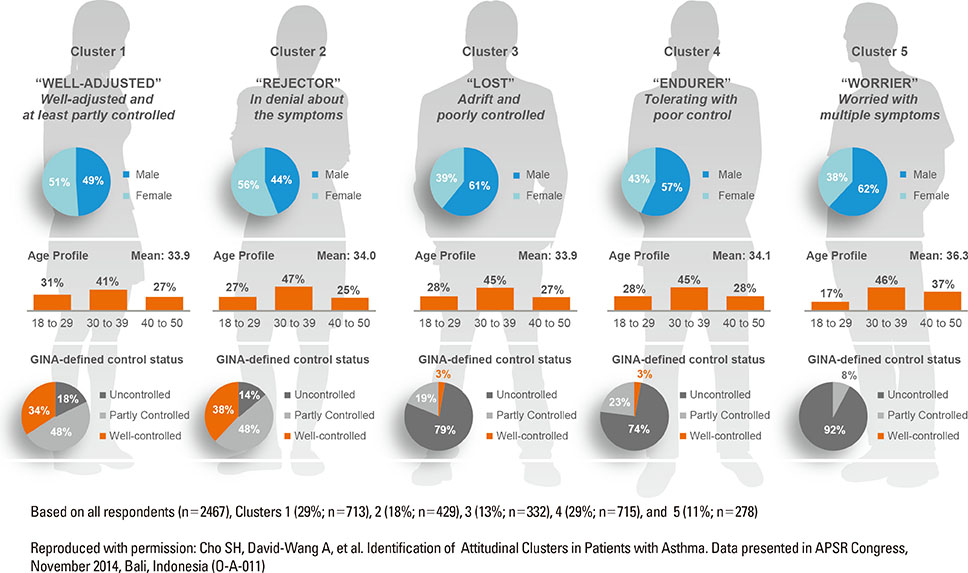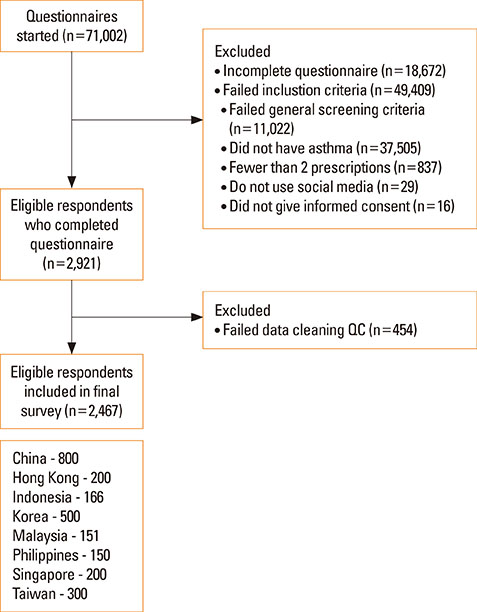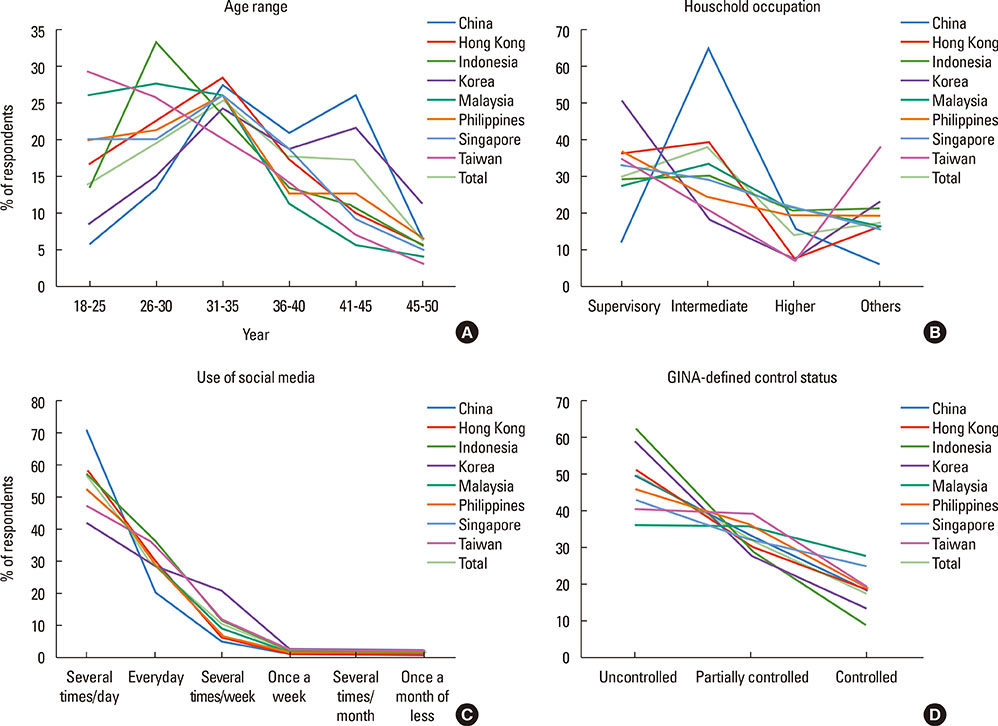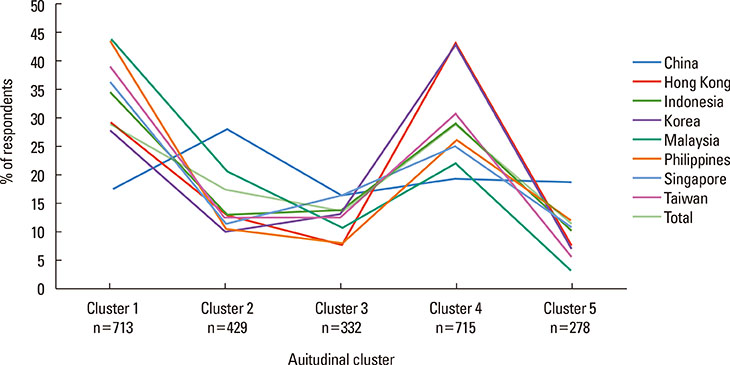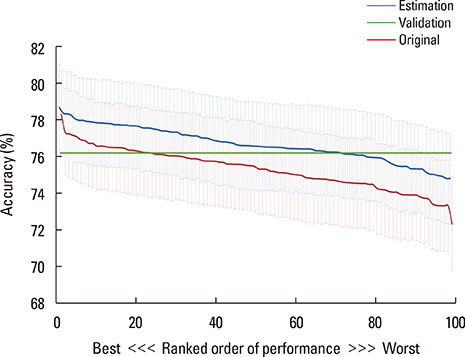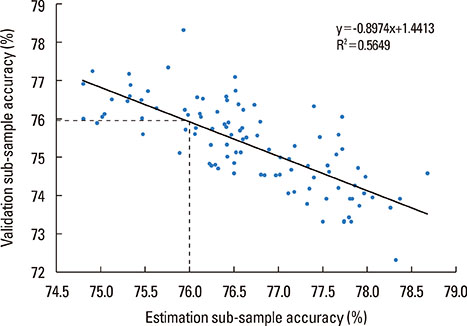Allergy Asthma Immunol Res.
2017 Jan;9(1):43-51. 10.4168/aair.2017.9.1.43.
Development and Validation of an Attitudinal-Profiling Tool for Patients With Asthma
- Affiliations
-
- 1Section of Pulmonary Medicine, University of the Philippines-Philippine General Hospital, Manila, Philippines. asdavidwang1@up.edu.ph
- 2Centre of Academic Primary Care, University of Aberdeen, Aberdeen, UK.
- 3Observational & Pragmatic Research Institute Pte Ltd, Singapore.
- 4College of Medicine, Seoul National University, Seoul, Korea.
- 5Department of Medicine, University of Hong Kong, Hong Kong Special Administrative Region, China.
- 6Faculty of Medicine, University of Malaya, Kuala Lumpur, Malaysia.
- 7Medical Affairs Department, Mundipharma Pte Ltd, Singapore.
- 8Research Partnership Pte Ltd, Singapore.
- KMID: 2355893
- DOI: http://doi.org/10.4168/aair.2017.9.1.43
Abstract
- PURPOSE
To develop a profiling tool which accurately assigns a patient to the appropriate attitudinal cluster for the management of asthma.
METHODS
Attitudinal data from an online survey of 2,467 patients with asthma from 8 Asian countries/region, aged 18-50 years, having had ≥2 prescriptions in the previous 2 years and access to social media was used in a discriminant function analysis to identify a minimal set of questions for the Profiling Tool. A split-sample procedure based on 100 sets of randomly selected estimation and validation sub-samples from the original sample was used to cross-validate the Tool and assess the robustness of its predictive accuracy.
RESULTS
Our Profiling Tool contained 10 attitudinal questions for the patient and 1 GINA-based level of asthma control question for the physician. It achieved a predictive accuracy of 76.2%. The estimation and validation sub-sample accuracies of 76.7% and 75.3%, respectively, were consistent with the tool's predictive accuracy at 95% confidence level; and their 1.4 percentage-points difference set upper-bound estimate for the degree of over-fitting.
CONCLUSIONS
The Profiling Tool is highly predictive (>75%) of the attitudinal clusters that best describe patients with asthma in the Asian population. By identifying the attitudinal profile of the patient, the physician can make the appropriate asthma management decisions in practice. The challenge is to integrate its use into the consultation workflow and apply to areas where Internet resources are not available or patients who are not comfortable with the use of such technology.
Keyword
MeSH Terms
Figure
Reference
-
1. Global Asthma Network. The global asthma report 2014 [Internet]. Auckland: Global Asthma Network;2014. cited 2015 Mar 25. Available from: http://www.globalasthmareport.org/burden/burden.php.2. World Health Organization. The global burden of disease: 2004 update [Internet]. Geneva: World Health Organization;2008. cited 2015 Feb 10. Available from: http://www.who.int/healthinfo/global_burden_disease/2004_report_update/en/.3. Lai C, Kim YY, Kuo SH, Spencer M, Williams AE. on behalf of the Asthma Insights and Reality in Asia Pacific Steering Committee. Cost of asthma in the Asia-Pacific region. Eur Respir Rev. 2006; 15:10–16.4. Thompson PJ, Salvi S, Lin J, Cho YJ, Eng P, Abdul Manap R, et al. Insights, attitudes and perceptions about asthma and its treatment: findings from a multinational survey of patients from 8 Asia-Pacific countries and Hong Kong. Respirology. 2013; 18:957–967.5. Lai CK, Ko FW, Bhome A, DE Guia TS, Wong GW, Zainudin BM, et al. Relationship between asthma control status, the Asthma Control Test™ and urgent health-care utilization in Asia. Respirology. 2011; 16:688–697.6. Zainudin BM, Lai CK, Soriano JB, Jia-Horng W, De Guia TS. Asthma Insights and Reality in Asia-Pacific (AIRIAP) Steering Committee. Asthma control in adults in Asia-Pacific. Respirology. 2005; 10:579–586.7. Lai CK, De Guia TS, Kim YY, Kuo SH, Mukhopadhyay A, Soriano JB, et al. Asthma control in the Asia-Pacific region: the Asthma Insights and Reality in Asia-Pacific Study. J Allergy Clin Immunol. 2003; 111:263–268.8. Price D, David-Wang A, Cho SH, Ho JC, Jeong JW, Liam CK, et al. Time for a new language for asthma control: results from REALISE Asia. J Asthma Allergy. 2015; 8:93–103.9. Price D, David-Wang A, Cho SH, Ho JC, Jeong JW, Liam CK, et al. Asthma in Asia: physician perspectives on control, inhaler use and patient communications. J Asthma. 2016; Forthcoming.10. Tan TL, Price D, Ho JC, Yunus F, Neira G. Defining well-controlled asthma: perspectives from patients and primary care physicians in Asia (Abstract CR020). NPJ Prim Care Respir Med. 2015; 25:15038.11. Global Initiative for Asthma. The global strategy for asthma management and prevention. [USA]: 2016 GINA Report, Global Strategy for Asthma Management and Prevention;2016. cited 2016 Aug 18. Available from: http://ginasthma.org/gina-reports/.12. Partridge MR, van der Molen T, Myrseth SE, Busse WW. Attitudes and actions of asthma patients on regular maintenance therapy: the INSPIRE study. BMC Pulm Med. 2006; 6:13.13. Price D, Fletcher M, van der Molen T. Asthma control and management in 8,000 European patients: the REcognise Asthma and LInk to Symptoms and Experience (REALISE) survey. NPJ Prim Care Respir Med. 2014; 24:14009.14. Holgate ST. Mechanisms of asthma and implications for its prevention and treatment: a personal journey. Allergy Asthma Immunol Res. 2013; 5:343–347.15. Braido F. Failure in asthma control: reasons and consequences. Scientifica (Cairo). 2013; 2013:549252.16. Nathan RA, Sorkness CA, Kosinski M, Schatz M, Li JT, Marcus P, et al. Development of the asthma control test: a survey for assessing asthma control. J Allergy Clin Immunol. 2004; 113:59–65.17. Juniper EF, O'Byrne PM, Guyatt GH, Ferrie PJ, King DR. Development and validation of a questionnaire to measure asthma control. Eur Respir J. 1999; 14:902–907.18. Deenen TA, Klip EC. Coping with asthma. Respir Med. 1993; 87:Suppl B. 67–70.19. Chetta A, Gerra G, Foresi A, Zaimovic A, Del Donno M, Chittolini B, et al. Personality profiles and breathlessness perception in outpatients with different gradings of asthma. Am J Respir Crit Care Med. 1998; 157:116–122.20. Park SY, Yoon SY, Shin B, Kwon HS, Kim TB, Moon HB, et al. Clinical factors affecting discrepant correlation between asthma control test score and pulmonary FUNCTION. Allergy Asthma Immunol Res. 2015; 7:83–87.21. Van Lieshout RJ, Macqueen G. Psychological factors in asthma. Allergy Asthma Clin Immunol. 2008; 4:12–28.22. Abdulwadud OA, Abramson MJ, Forbes AB, Walters EH. The relationships between patients' related variables in asthma: iplications for asthma management. Respirology. 2001; 6:105–112.23. Axelsson M, Emilsson M, Brink E, Lundgren J, Torén K, Lötvall J. Personality, adherence, asthma control and health-related quality of life in young adult asthmatics. Respir Med. 2009; 103:1033–1040.24. Jones CA, Bender BG, Haselkorn T, Fish JE, Mink DR, Peters SP, et al. Predicting asthma control using patient attitudes toward medical care: the REACT score. Ann Allergy Asthma Immunol. 2009; 102:385–392.25. Lightspeed GMI (US). Lightspeed GMI quality suite [Internet]. Warren (NJ): Lightspeed GMI;2014. cited 2015 Mar 30. Available from: http://www.lightspeedgmi.com/services/lightspeed-gmi-quality-suite/.26. Cho SH, David-Wang A, Ho JC, Jeong JW, Liam CK, Lin JT, et al. Identification of attitudinal clusters in patients with asthma: analysis from REALISE Asia. Respirology. 2014; 19:4.27. Chisholm A, Price D, Pinnock H, Tan TL, Roa C, Cho SH, et al. Personalising care of adults with asthma from Asia: a modified e-Dephi consensus study to inform management tailored to attitude and control profiles. npj Primary Care Respiratory Medicine. [accepted, in press 2016 Jun 22].28. Büyüköztürk Ş, Çokluk-Bökeoğlu Ö. Discriminant function analysis: concept and application. Eurasian J Educ Res. 2008; 33:73–92.29. iHARP: Inhaler technique assessment initiative helping asthma in real-life patients [Internet]. [place unknown]: iHARP;2014. cited 2014 Oct 3. Available from: http://iharp.org/questionnaire.aspx.30. Hair JF Jr, Anderson RE, Tatham RL, Black WC. Multivariate data analysis: with readings. 4th ed. Upper Saddle River (NJ): Prentice-Hall Inc.;1995.31. Moss S. Cross validation in discriminant function analysis [Internet]. [Australia]: SICOTESTS;2008. 2015 Jul 12. cited 2015 Dec 10. Available from: http://www.psych-it.com.au/Psychlopedia/article.asp?id=157.32. Arlot S, Celisse A. A survey of cross-validation procedures for model selection. Stat Surv. 2010; 4:40–79.33. Mangan JM, Wittich AR, Gerald LB. The potential for reducing asthma disparities through improved family and social function and modified health behaviors. Chest. 2007; 132:789S–801S.34. Song WJ, Cho SH. Challenges in the management of asthma in the elderly. Allergy Asthma Immunol Res. 2015; 7:431–439.

